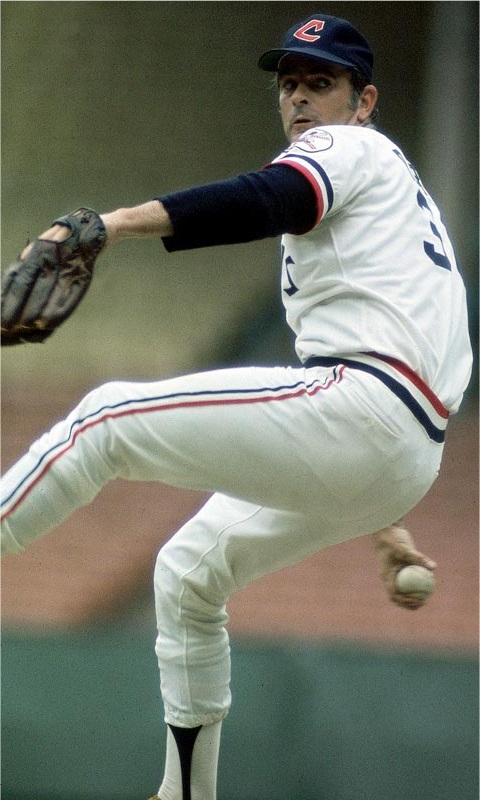Publisher's note: We believe the subject of history makes people (i.e., American people) smarter, so in our quest to educate others, we will provide excerpts from the North Carolina History Project, an online publication of the John Locke Foundation. This fiftieth installment, by Jonathan Martin, was originally posted in the North Carolina History Project.
Born Gaylord
Gaylor Perry in 1972: Above.
Jackson Perry in September 15, 1938, in Williamston, North Carolina, Perry competed at every level and in every sport during his early years and through high school in Martin County. His best sport, though, was baseball. A right-handed pitcher who specialized in throwing fastballs pitched for Williamston High School during the late 1950s, and scouts from around the country visited the small town of Williamston to watch the hard-throwing pitcher.
In Baseball in the Carolinas, Parker Chesson, a Perquimans County high school pitcher who competed against Perry, recalled a game on April 1, 1958 when he pitched against Perry. Chesson writes that "at 6'4" and about 200 pounds, he was an imposing figure, and he had a blazing fastball. Talent wise, he was in another league." Chesson remembers he was nervous that game because scouts from major league teams were there observing Perry, and he thought he could muster an impressive performance so maybe the agents could notice him as well. It was not meant to be, and the day after the game a sport headline from the News & Observer read "Perry struck out 15 and walked one in besting Hertford's Chesson in a tight pitching duel. Each allowed four hits, and Chesson fanned four."
One of the scouts present at the Chesson-Perry matchup was Tom Sheehan, one of the San Francisco Giants' most prominent agents and scouts. Sheehan, after observing several innings of Perry's pitching, made arrangements to sign Perry. Shortly after the game, the Giants approached with the largest contract that the baseball franchise had theretofore offered to an incoming rookie. In June 1958, the young Perry accepted the Giants' offer of $70,000 in a three-year salary contract. Perry spent several years playing in the minors and after attending Campbell University for two years, he joined the major league Giant team in 1962. (Campbell University's mascot is named after Gaylord Perry; interestingly, Perry never played a baseball game while studying at Campbell).
A pitcher competitive to the core, Gaylord earned fame and notoriety due to his confusing tactics and for "doctoring" the baseballs he threw. During his career, Perry was known for covering baseballs with odd ointments such as petroleum jelly, rosin, salt and pepper, and even chocolate sauce. The presence of gel or another type of agent caused the ball to spin or add to the effect of Perry's intricate pitches. For some games, the derisive pitcher rubbed his whole body down with Capsolin which causes above average perspiration. Perry was well-known for illegal throws such as scuffballs, greaseballs, spitballs, and even puff balls (a cloud of rosin left Perry's hand as he threw the ball to the plate which greatly distracted the batter). Even when Perry did not doctor the ball, he performed a unique on-the-mound custom. The pitcher touched his nose, ear, neck, shoulders, elbows, and cap brim, before making a throw, and he continued this routine to keep batters in an imbalance. When asked about his tactics, Perry responded, "Having 'em think you're throwing 'em [illegal pitches] is as good as doing it." In 1974, the slick pitcher published a book Me and the Spitter, and he protests that he gave up using illegal baseballs. When fans approach Perry with questions about his sly methods, the pitcher takes an oath of silence and affirms that he does not recall using anything to doctor baseballs.
Another interesting story of Perry's career remains the home run and the man on the moon tale. In 1962, during batting practice, Manager Alvin Dark spoke with San Francisco reporter, Harry Jupiter, about the new rookie pitcher. When asked about Perry's hitting, Dark remarked, "There'll be a man on the moon before Gaylord Perry hits a home run." The prophecy proved true because seven years later Neil Armstrong walked across the face of the moon on July 20, 1969. Moments after Armstrong traversed the moon, Perry hit his first home run in the baseball major league at Candlestick Park against the L.A. Dodgers. When he was asked about this story, Perry said, "True story. I could hit fine in batting practice."
The famous pitcher retired after playing twenty-two seasons, and he later founded and established Limestone College's baseball program in Gaffney, South Carolina. Perry coached the team from 1988 to 1991, and he later retired to Spruce Pine, North Carolina. He stays busy fishing and he will make a public appearance every once in awhile.
During the 1960s, Gaylord Perry became one of the most effective pitchers in the National League. Part of the Giant squad from 1962 until 1971, Perry won 134 games, and in the 1966 and 1970 seasons he topped the twenty win mark. After his time in San Francisco, Perry pitched for seven different teams, and his career lasted for twenty-two seasons. Gaylord achieved 314 wins, threw 3,534 strikeouts (6th all time), and boasts a 3.10 ERA during his baseball tenure. In 1991, the North Carolinian pitcher was inducted into the Baseball Hall of Fame. Perry holds the distinction as being the first pitcher to win the Cy Young Award in both the National and American League.
Sources:
"Perry, Gaylord." National Baseball Hall of Fame Website. http://baseballhall.org/hof/perry-gaylord, (accessed October 24, 2011).
"Gaylord Perry." Elizabeth McGarr. Sports Illustrated. Volume 111, Issue 2 (7/13/2009).
"On Sports: New Tricks from an Old Spin Doctor." Frederick C. Klein. Wall Street Journal (Eastern Edition). New York, NY: Jan 1995.
"A Gaylord Perry Story." Parker Chesson. Baseball in the Carolinas. Chris Holaday ed. McFarland & Company, Inc. 2002.
"1984 - Gaylord Perry." Hall of Fame of Campbell University Athletics website. http://www.gocamels.com/hof, (accessed October 24, 2011).

